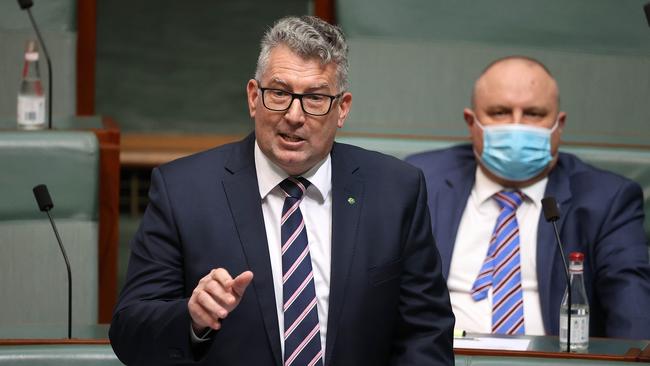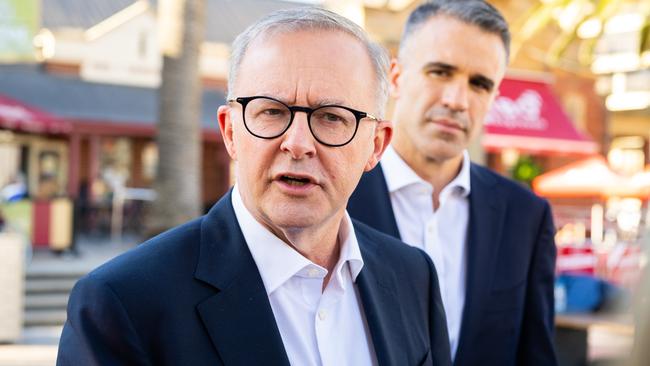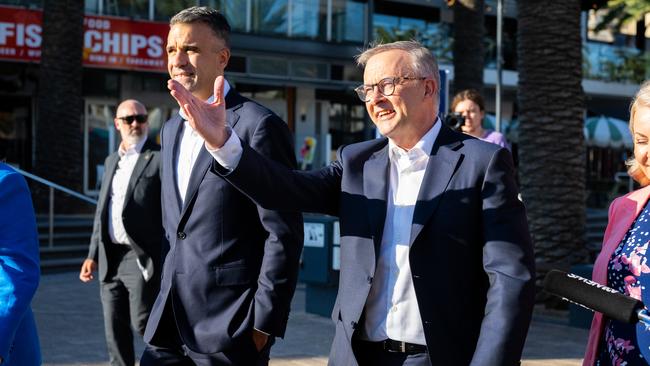Albanese promises SA a Murray Darling Basin fix
Labor has not ruled out using water buybacks as part of its plan to deliver an extra 450GL to the river by 2024, infuriating the National Party.
SA News
Don't miss out on the headlines from SA News. Followed categories will be added to My News.
Labor has not ruled out using controversial water buybacks under its election promise to return an extra 450GL to the River Murray and bring the National Water Commission out of mothballs.
The Coalition has attacked Opposition leader Anthony Albanese’s plan as “town-destroying”.
“Re-establishing a Water Commission and conducting yet another study will not produce one single extra drop for South Australia,” Water Minister Keith Pitt said.
“Mr Albanese has all but confirmed Labor will reintroduce water buybacks that have been so damaging to Murray-Darling Basin communities.”

A water buyback is a method where the federal government purchases water entitlements from farmers to reduce the volume of water taken out of the river system.
Opposition water spokeswoman Terri Butler said Labor would “do what is needed” to restore an extra 450GL for the environment by 2024 – a promise made to SA under the Murray Darling Basin Plan.
“We are not going to actively pursue, unless we have to, the policy of voluntary buybacks, but I will certainly say we are not going to rule it out,” Ms Butler said in Adelaide on Friday.
“I don’t think it has to come to it (buybacks), I think we can all agree that if the jurisdictions work together they can avoid the need for any further discussions.”
Ms Butler insisted she does not “want to see buybacks”.
Mr Albanese revealed on Friday revealed his “five-point plan” to give SA its full share of freshwater.
The top priority of his plan is restoring an extra 450GL to the river system, which would help the environment in channels and flood plains across SA, NSW and Victoria.
This commitment is on top of the 2075GL that must be recovered for the environment across the entire basin each year.
Victorian Labor Water Minister Lisa Neville labelled the policy “disappointing”, telling rural ABC Radio that “NSW and ourselves would not agree to any of those changes”.

Mr Albanese said “only Labor has a real commitment to meet the needs of South Australians”.
“I will ensure full compliance and maximum transparency – no more fudging the rules.”
Just 2GL has been returned to the river under the Coalition, which Mr Albanese described as “barely a trickle of water”.
“This government has failed South Australians and failed the Murray River.”
Labor promised to spend $26m to re-establish the National Water Commission – an independent statutory authority that was abolished by former prime minister Tony Abbott in 2014.
Labor said the new commission would “drive ongoing water reform and future-proof Australia’s water resources, bringing national leadership and fairness into water policy”.
Under the Murray Darling Basin Plan, 450GL must be returned to the river for the environment by 2024.
Mr Albanese vowed to stick to that deadline.
A key feature of his river plan is increasing compliance across the Basin, investing an extra $35m for improved water metering and monitoring.
Other measures include:
-Implementing ACCC recommendations and making more data publicly available
-Increasing First Nations ownership of water entitlements
-Spending $12m on new studies, “updating the science” of the Basin Plan.
Labor would also consider bringing forward the 2026 review of the plan.

SA senator Penny Wong attacked Nationals leader Barnaby Joyce, who wanted to scrap the 450GL entitlement.
“People in SA will never forget that during the millennium drought, Barnaby Joyce told them to ‘move to where the water is’,” Senator Wong said.
Mr Albanese visited Glenelg in the marginal seat of Boothby with Premier Peter Malinauskas and candidate Louise Miller-Frost on Thursday, promising a $10m investment towards Holdfast Bay Council’s Jetty Rd masterplan.
The next stage of the project is to upgrade the stretch from Colley Tce to Partridge St.
The works would allow for more outdoor dining, improve pedestrian access and upgrade the streetscape.
More Coverage
Read related topics:Environment & Climate




